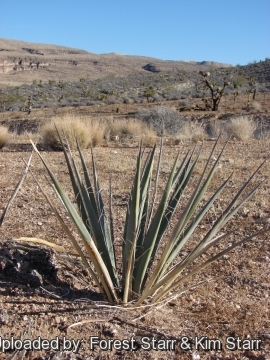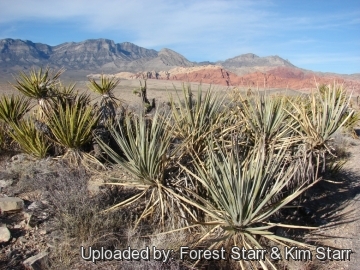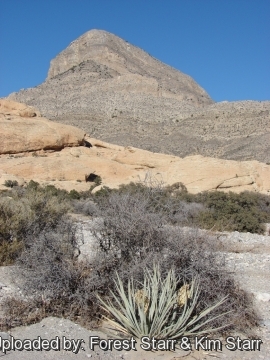Accepted Scientific Name: Yucca baccata Torr.
Rep. U.S. Mex. Bound., Bot. [Emory] 2(1): 221 (1858)

Sarcoyucca baccata (Yucca baccata) Photo by: Forest Starr & Kim Starr
Flowering habit at Calico Hills Sandstone Quarry Calico Tanks trail Red Rocks, Nevada. December 26, 2007.
Origin and Habitat: Yucca baccataSN|29966]]SN|29966]] is a common species of yucca native to the deserts of the southwestern United States (Arizona, Californis, Colorado Nevada, New Mexico, Texas, Utah) and northwestern Mexico (Sonora and Chihuahua). It is also reported in the wild in Colombia.
Altitude range: 400–2500 metres above sea level.
Habita and Ecology: It can be found in several habitat types, including dry Joshua-tree woodland, Pinyon-Juniper, Sagebrush, and ponderosa pine colonies. It is associated with Yucca schidigera, Yucca faxonianaSN|30019]]SN|29981]], Yucca arizonicaSN|29983]]SN|29983]], Yucca faxonianaSN|30019]], Agave utahensisSN|581]]SN|581]], and other Agave species. It can be found among Sclerocactus, Pediocactus, Navajoa, and Toumeya species. Although flowers usually appear every year, fruit may not always develop. Yucca is pollinated exclusively by a small white yucca moth that stays in the flower during the day and at night carries the pollen from flower to flower. When it does develop, the banana-shaped, fleshy fruit of the Yucca baccataSN|29966]]SN|29966]] matures. Y. baccata specimens from the higher, mountainous regions of the Rocky Mountains is winter hardy and tolerates extreme conditions.
Synonyms:
See all synonyms of Yucca baccata
back
Accepted name in llifle Database:Yucca baccata Torr.Rep. U.S. Mex. Bound., Bot. [Emory] 2(1): 221 (1858)Synonymy: 12
Accepted name in llifle Database:Yucca baccata var. brevifolia L.D.Benson & DarrowAmer. J. Bot. 30: 234 (1943).Synonymy: 7
back
Common Names include:
ENGLISH: Datil yucca, Banana yucca, Wide leaf yucca, Blue yucca, Spanish bayonet, Soapweed
ARABIC ( لعربية ): يوكا توتية
CATALAN (Català): Dàtil Iuca, Banana Iuca
HUNGARIAN (Magyar): Bogyós pálmaliliom, Bogyós jukka
NAVAJO (Diné Bizaad): Tsáʼásziʼ bideeʼí
Description: Yucca baccata, also called "Banana yucca", is recognized by having (usually) no leafy stem, the crowns sitting level with the ground varies from 30 to 90 cm tall and wide. The flower stems are usually short nested inside or just above the stiff leaves, while the fruits are quite long and banana shaped, turning reddish when ripe. In the spring of the year, a green stalk that looks a little like an asparagus emerges from the crown of the plant. Later, the young flowers start to develop, opening at the top of the stalk first. At full development, the flower stalk lengthens to support the large creamy white flowers. The yucca in blossom is very handsome and is during this stage that the plant is most attractive to photographers and painters and is often sought for book covers and calendars depicting the great Southwest. Yucca baccata occurs in a large area of the North American deserts and exhibits much variation across its range. Two varieties are recognized, the nominate form and var. brevifolia.
Derivation of specific name: The species gets its common name "banana yucca" from its banana-shaped fruit. The specific epithet "baccata" means "with berries." Banana yucca is closely related to the Mojave yucca (Yucca schidigera), with which it is interspersed where their ranges overlap; hybrids between them occur.
Stems; Short or non existent. Stems, if present, 1 to 6(-24), aerial or subterranean, usually shorter than 0.3 m (rarely up to 2.5 m long and decumbent), simple or sometimes branched.
Rosettes: ± open, solitary or in small clumps.
Leaves: Evergreen; swordlike, spine tipped, (30-)50–75(-100) cm long, 2–6 cm wide dark green to bluish green, concavo-convex, rigid, scabrous or glaucous, expanded base ± 10 cm wide reddish; Leaf margins brown coarse, curling (var. baccata) or fibrous-shredding (var. brevifolia).
Blooming season; It flowers in the spring, starting in April to July depending on locality and altitude.
**Inflorescence: Erect, paniculate, dense, ovoid, not especially tall, typically 60-80(-150) cm arising completely within or extending 1/4 beyond rosettes, glabrous, rarely slightly pubescent and purple-tinged. Peduncle scapelike (20-)60-80 cm long.
Flowers: Pendent. Perianth 5 to 13 cm long, nearly as wide, bell-shaped, tepals lanceolate (outer narrower), connate basally to form shallow floral cup 7–12 mm, usually cream-colored, occasionally tinged with purple inside, 4.5–13 cm, reddish brown outside. Filaments connate proximally into collarlike structure, 3.2–12 mm, fleshy, pubescent; anthers 5–7 mm. Pistil 5–8 cm long. Ovary 0.7–1.2 cm. Style 5–7 mm; stigmas distinct.
Blooming season (in habitat): March-May (spring), June-August (summer).
Fruits: Leathery, baccate, indehiscent, fleshy, succulent, sweet when young, eventually pendent, (5-)8–18(-23) cm long and 4-6(-7.5) cm across, and cylindrical. Fruits appear from May to September, depending on the elevation.
Seeds:*** Rough, dull black, obovate, wingless, (3-)7-8(11) mm long and wide, 1-2(-3) mm thick; they ripen in 6–8 weeks.
Subspecies, varieties, forms and cultivars of plants belonging to the Yucca baccata group
 Yucca baccata Torr.: (var. baccata) Plants acaulescent or caulescent; stems 1–6, aerial or subterranean, shorter than 0.3 m; leaf margins coarse, curling.
Yucca baccata Torr.: (var. baccata) Plants acaulescent or caulescent; stems 1–6, aerial or subterranean, shorter than 0.3 m; leaf margins coarse, curling.- Yucca baccata var. brevifolia L.D.Benson & Darrow: Plants caulescent; stems 1–24, aerial, often branched, some reaching 2 m; leaf margins filiferous.
Bibliography: Major references and further lectures
1) Forest & Kim Starr “Yucca baccata (Banana yucca)”. Plants of Hawaii. <http://www.starrenvironmental.com>. Web. 5 Jan. 2015.
2) Carolyn Niethammer “American Indian Cooking: Recipes from the Southwest” U of Nebraska Press, 01 November 1999
3) George Oxford Miller “Landscaping with Native Plants of Southern California” Voyageur Press
4) Wikipedia contributors. "Yucca baccata." Wikipedia, The Free Encyclopedia. Wikipedia, The Free Encyclopedia, 24 Aug. 2014. Web. 5 Jan. 2015.
5) Urs Eggli “illustrated Handbook of Succulent Plants: Monocotyledons: Monocotyledons” Springer Science & Business Media, 17 July 2001
6) Linda Jamison, Richard Jamison “Primitive Skills and Crafts: An Outdoorsman's Guide to Shelters, Tools, Weapons, Tracking, Survival, and More” Skyhorse Publishing, Inc., 13 December 2013
7) Fritz Hochstätter “Yucca (Agavaceae). Band 1 Dehiscent-fruited species in the Southwest and Midwest of the USA, Canada and Baja California”, Selbst Verlag, 2000
8) Fritz Hochstätter “Yucca (Agavaceae).” Band 2 Indehiscent-fruited species in the Southwest, Midwest and East of the USA, Selbst Verlag. 2002.
9) Fritz Hochstätter “Yucca (Agavaceae). Band 3 Mexico, Selbst Verlag, 2004.
10) "Common names of yucca species" <http://www.yuccaagavaceae.com/species.html> Web. 5 Jan. 2015.
11) John D. Stuart and John O. Sawyer “Trees and Shrubs of California” California Natural History Guides 2001
12) Abrams, L. “Ferns to Birthworts.” 1: 1–557. In L. Abrams (ed.) Ill. Fl. Pacific States. Stanford University Press, Stanford.1923.
13) CONABIO. “Catálogo taxonómico de especies de México. 1.” In Capital Nat. México. CONABIO, Mexico City. 2009.
14) Correll, D. S. & M. C. Johnston. “Man. Vasc. Pl. Texas” i–xv, 1–1881. The University of Texas at Dallas, Richardson.1970.
15) Flora of North America Editorial Committee, e. 2002. "Flora of North America. Magnoliophyta: Liliidae: Liliales and Orchidales" Vol 26,i–xxvi, 1–723: "Yucca baccata" <http://www.efloras.org/florataxon.aspx?flora_id=1&taxon_id=242102056> Web. 5 Jan. 2015.
16) Great Plains Flora Association. “Fl. Great Plains” i–vii, 1–1392. University Press of Kansas, Lawrence.1986.
17) Hickman, J. C. “The Jepson Manual: Higher Plants of California” 1–1400. University of California Press, Berkeley.1993.
18) Shreve, F. & I. L. Wiggins. “Veg. Fl. Sonoran Des.” 2 vols. Stanford University Press, Stanford. 1964
19) Jepson Flora Project: "Yucca baccata" <http://ucjeps.berkeley.edu/cgi-bin/get_JM_treatment.pl?Yucca%20baccata> Web. 5 Jan. 2015.
 Habit at Red Rock Vista, Nevada. December 22, 2007. (Yucca baccata) Photo by: Forest Starr & Kim Starr
Habit at Red Rock Vista, Nevada. December 22, 2007. (Yucca baccata) Photo by: Forest Starr & Kim Starr Habit next to Yucca schidigera at Red Rock Vista, Nevada. December 22, 2007. (Yucca baccata) Photo by: Forest Starr & Kim Starr
Habit next to Yucca schidigera at Red Rock Vista, Nevada. December 22, 2007. (Yucca baccata) Photo by: Forest Starr & Kim Starr Habit at Calico Hills Sandstone Quarry Calico Tanks trail Red Rocks, Nevada. December 26, 2007. (Yucca baccata) Photo by: Forest Starr & Kim Starr
Habit at Calico Hills Sandstone Quarry Calico Tanks trail Red Rocks, Nevada. December 26, 2007. (Yucca baccata) Photo by: Forest Starr & Kim Starr Habit at Childrens Discovery Loop trail Red Rocks, Nevada. December 26, 2007. (Yucca baccata) Photo by: Forest Starr & Kim Starr
Habit at Childrens Discovery Loop trail Red Rocks, Nevada. December 26, 2007. (Yucca baccata) Photo by: Forest Starr & Kim StarrCultivation and Propagation: Yucca baccataSN|29966]]SN|29966]] is a carefree trunkless and durable plant that become the centre of attention. when it blooms. It give the landscape a distinctive desert flavour. Its knee-high height suits it to midgarden placement and side-yard or corner plantings. The bladelike leaves add vertical structure to a cactus or xeriscape garden. This small yucca has become one of the most sought after of the woody lilies. This species is highly tolerant of drought, frost and heat. Like their larger counterparts, these yuccas have needle-tipped leaves, so don't plant them near play or walk areas.
Soil: Plant in very fast draining soil. It is adapted to a hot, dry environment, but has some tolerance to moisture and humidity when planted in a very well-draining soil. It is noted as preferring alkaline conditions.
Waterings: Provide little or no water in winter. Treat like a succulent. However, they grow faster if watered well (don't water the crown, though they rot easily). In the garden they should be placed in a sunny, well-drained area with additional summer water in dry climates.
Exposure: They thrive best in full sun, but can be grown with some shade and humidity, but may become leggy.
Hardiness. Best where winter temperatures stay above 0° C, but is hardy to around -10 to-18° C (depending on provenance). Plants in containers can be moved inside during longer cold spells.
Maintenance: Remove dead basal leaves and spent fruiting stalks for a clean landscape appearance.
Garden uses: These make great specimen plants for xeriscape gardens and blend well in either tropical or arid gardens. Small plants are relatively inexpensive, but larger ones are a fortune. These make excellent potted specimens, and their symmetrical form provides a striking focal point, ans display wonderful shadows when illuminated by night lighting. In cooler climates they thrive well in gravel garden, as they have proven quite hardy because of the excellent drainage.
Food uses: The banana-shaped, fleshy fruit of the Yucca baccataSN|29966]]SN|29966]] matures to about 8-18 cm long. This plant was important to the early people of the Southwest because of its abundance as a food source. The fruits were the most relished part of that plant. The fruits were eaten raw, baked, boiled, and ground into meal. The Paiutes dried the fruits for use during the winter. The tender central leaves were also cooked in soups, boiled with meat, and used in a variety of culinary combinations.
Propagation: Propagation: fresh seeds or cuttings (If available).















